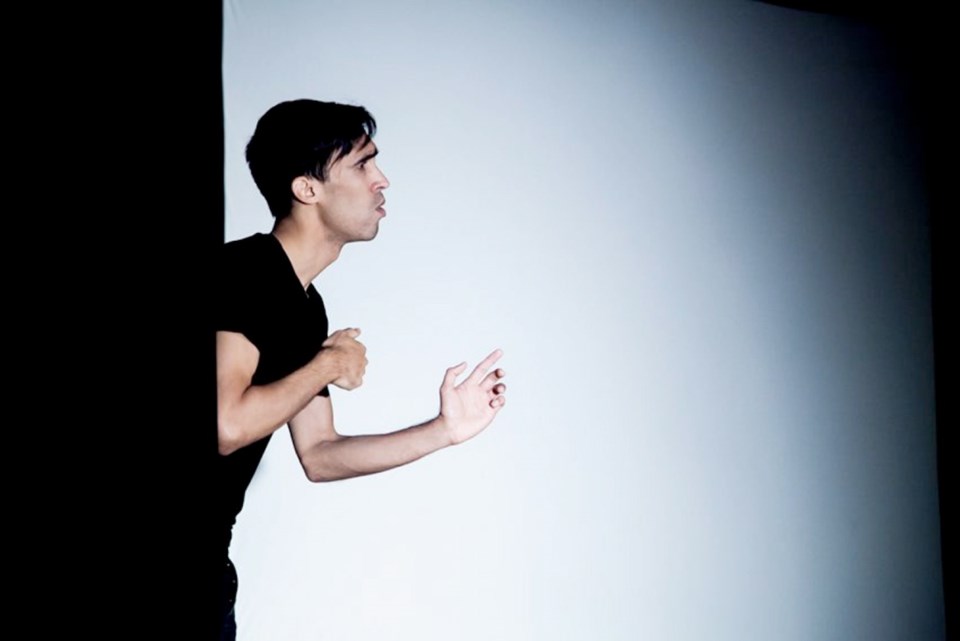What: Imaginary Anthropologies featuring Gabriel Dharmoo
When: Saturday, 8 p.m.
Where: Open Space, 510 Fort St.
Tickets: $16 ($11 students/seniors/members) at anthropologies.bpt.me or 1-800-838-3006; $20 ($15 students/ seniors/ members) at the door
In the satirical world of Gabriel Dharmoo, truth is indeed stranger than fiction. But just because something is not true does not mean audiences can’t be convinced it is real.
A performance piece involving truth, mistruths and art both real and imagined is a nebulous exercise, Dharmoo said. Which is precisely what motivated the Canadian composer to write Imaginary Anthropologies, a live art and solo vocal performance that explores imaginary folklore.
He sees Imaginary Anthropologies, winner of the best international production prize at last year’s Amsterdam Fringe Festival, as a way of dissecting what we know as a society and what we are inclined to believe. In his radical mind, the content of performance art rarely has to be presented as true for it to be engaging.
“I’m always interested in presenting techniques that might exist being mixed with something that does not, so I can label them imaginary,” Dharmoo, 34, said recently from his home in Montreal.
“The interest I have is between what could be traditional, or what could be experimental — that grey zone.”
He travels through a musical rollercoaster on Imaginary Anthropologies, with no end to the possibilities. He takes attendees through a world of 11 fictive populations. The beauty is that the audience doesn't immediately know whether they are real or fabricated, Dharmoo said.
“It becomes less credible as it goes along, as do the populations and the rituals. I love the transformation of truth meets fiction.”
The Quebec City native is backed during the solo performance by a video of ethno-musicologists talking (in French, with English subtitles) about these ancient cultures.
There is an official air to it all, akin to something the CBC might have produced for television during the 1970s, with Dharmoo as the show’s central character.
His vocal delivery is close to Tibetan throat singing in the sense that he uses overtone singing, a practice that produces two notes simultaneously.
He is not a trained singer, in the traditional sense, though he has done his share of practical musical training.
An accomplished cellist, he researched Carnatic music in India with masters of the form.
Out of respect, he wishes to remind ticketholders that he does not know the first thing about proper technique.
“I’m a trained western classical musician but I’m not a trained western classical singer, so my voice doesn’t have a cultural weight.”
He is studying for a PhD from Concordia University in Montreal in the individualized program, which allows researchers to think outside the box in a variety of media.
Dharmoo is not alone in such a pursuit. The exploration of imaginary culture and imaginary folklore, or fictionalized Early Music, is more popular than some might think, he said.
Dharmoo performed Imaginary Anthropologies at a 2014 symposium in Germany, one that was centred on challenging current academic formats.
It was an eye-opener for Dharmoo, who learned he is unique in that his approach involves primarily vocal technique and performance, and very little in the way of printed material supported by facts and figures.
Dharmoo throws his body into each night, and becomes a lithe, elasticized, esthetically intriguing version of himself. He said he does so to make contemporary what is presented as ancient singing techniques.
He has won raves for the totality of his work, but he’s quick to remind those not up to speed on enthno-musicology just how strange the real world can get.
“Lots of music and practices, the real ones, are unbelievable. They are so bizarre. In Papua New Guinea, there’s a tribe that uses a big cricket, which they put close to their mouth, and sing through it so it can create overtones. I could have made that up and put it in my piece, and people would have thought it was fake.”


-thumb.png;w=120;h=80;mode=crop)
